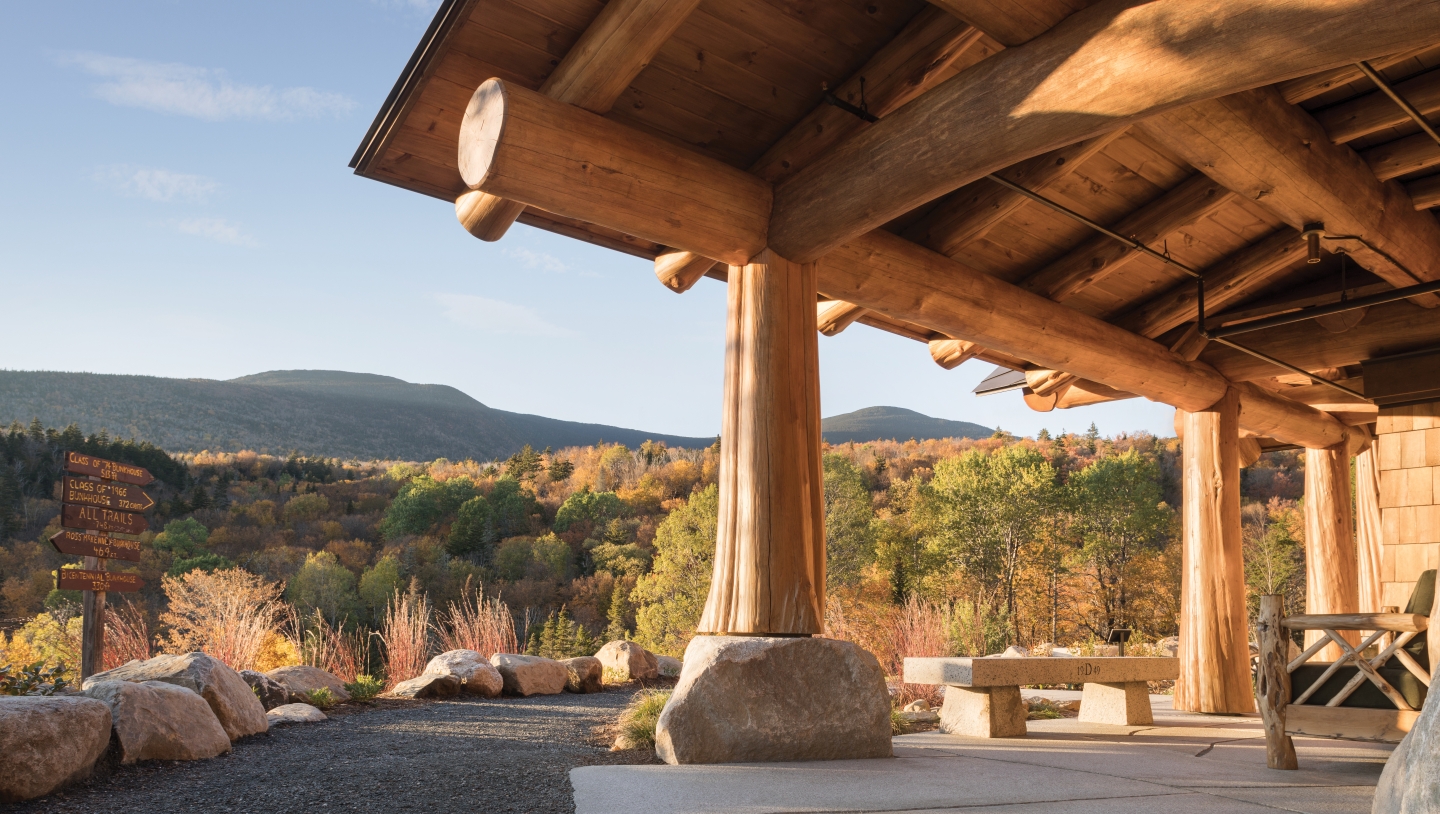In the dying light of a September evening in 2016, in a remote mountain cabin 45 miles from Hanover, they gathered for the last supper. Former Dartmouth Outing Club members, lodge crew, students, faculty, alumni—even parents with their children—came together for one last Thanksgiving-style feed and a chance to pay their respects. After years of study and passionate, sometimes tear-filled debate, the decision had been made to tear down the College’s aging Moosilauke Ravine Lodge and replace it with something new. Demolition would begin the following day.
Inside the lodge, they squeezed onto benches at wooden tables that had been pushed together in long rows, crowding the great room. Small bouquets of end-of-season wildflowers—orange hawkweed, yellow-tipped Indian blankets—dotted the table settings. Green-aproned Dartmouth students filled the tables with heaping platters of turkey, bowls of gravy, steaming potatoes. From the tables and from windowsills and along the mantel of the old stone fireplace votive candles softly flickered.
Laughter and talk and spontaneous reunions animated the room. Above the din, as the food was being passed around, an alum from the class of ’06 said, “This is great! They should tear down the lodge every year!” Across the table professor David Kotz ’86 turned and said, more quietly, “Yeah. Isn’t this when old friends get together? Weddings—and funerals.”
During dessert Jack Noon ’68, who knew the old building as intimately as anyone, stood up and shared memories of managing the lodge over several summers in the 1970s. He talked about the creosoting parties and the first time he’d come here: looking on, rapt, as President John Sloan Dickey ’29 told the freshman trippees about the importance of “place loyalty.”
Whitney Flynn ’07 stood up and recalled how she hadn’t felt at home at Dartmouth until she worked at the Ravine Lodge. “It had something to do with stewardship,” she said. “Following so many upperclassmen and elders who were willing to share their experiences and pass down their traditions…it felt like looking into the eyes and hearts of strangers and recognizing family.”
Rory Gawler ’05 read a poem he’d written for the occasion. He wrote of beams with the burnished sheen of a cherished instrument, a patina of timeless affection.

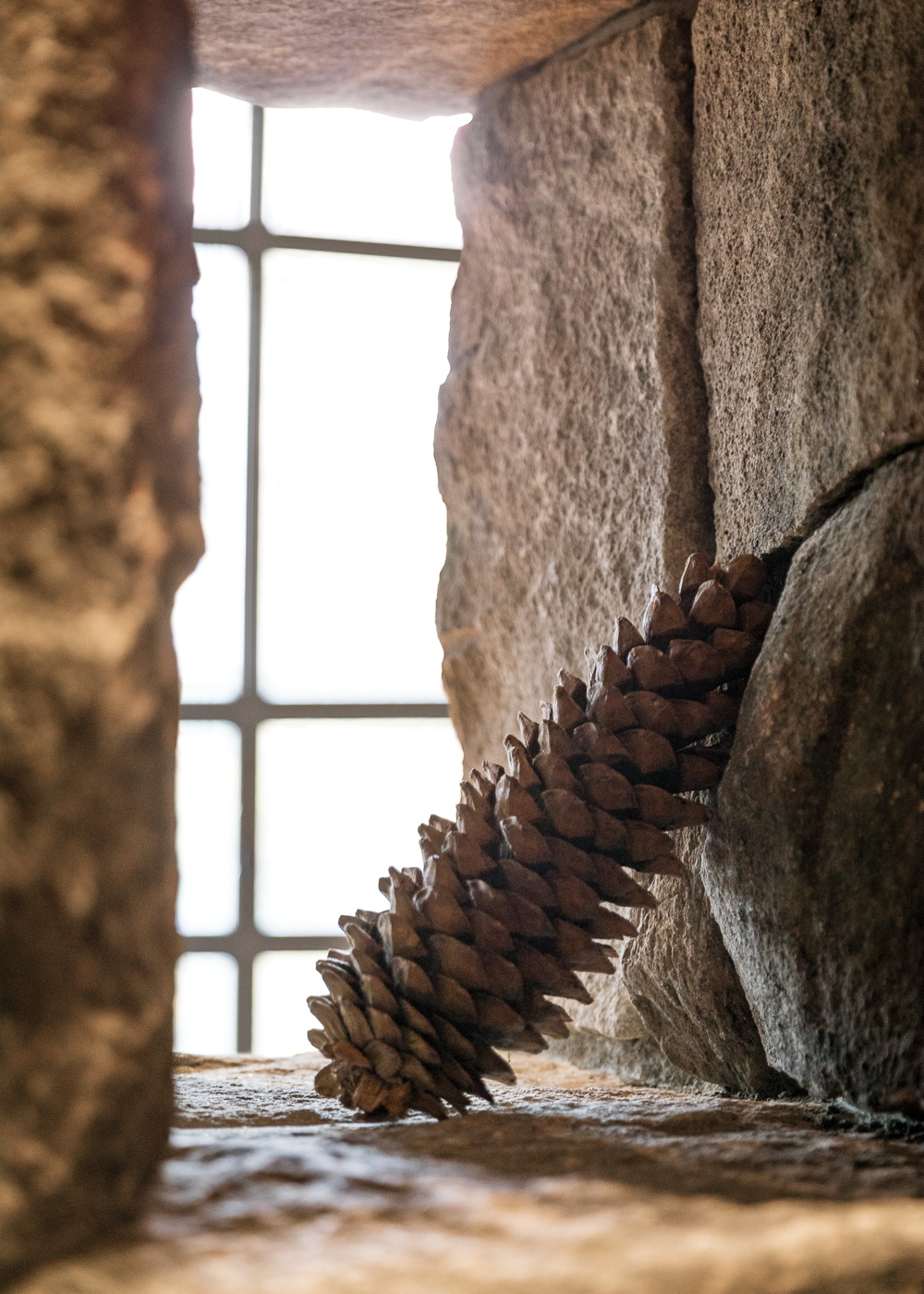
Afterward, as crew members cleared the tables and stacked them out on the side porches, caller David Millstone and muscle memory led the alums through the contras and squares and the “Salty Dog Rag.” The floor swayed underfoot. Later, as everybody sat around the old fireplace, Evan Skow ’03 leisurely recited a 40-minute version of the Doc Benton ghost story (many here had heard his virtuosic two-hour version), surrounded by all those mounted animal heads and moose antlers and wooden skis and framed black-and-white photos and old trail signs, all that campy decoration and burnished patina, all those memories and rituals that connected thousands of Dartmouth students across the decades. Anybody looking on could tell this wasn’t just a cabin in the woods or another College-owned building. It was more like a beloved retreat that had absorbed the imprint of generations of the Dartmouth family. Within a couple of days it would no longer exist.
To those who knew the long history of the Ravine Lodge, that it still existed at all was a miracle. The log structure had been built as a ski lodge in the summer and fall of 1938, just as the trails on Mount Moosilauke were blazing Dartmouth’s position atop the new collegiate sport of downhill ski racing. The College’s legendary woodcraft advisor Ross McKenney led the construction, overseeing a crew of professional woodsmen from the nearby town of Warren. Architect R.D. Butterfield ’30 made the bold decision to forgo an easier, flatter building site just to the north, which would have sheltered the lodge and placed it looking down the valley. He set it instead on a steep and difficult perch, facing into the teeth of the prevailing north-northwest wind—but looking up at Moosilauke’s summit 2,200 feet above. With spruce logs cut from nearby Jobildunc Ravine, using axes and adzes, hand tools, two draft horses and no power equipment save a gas-powered cement mixer, McKenney’s crew built a crude but dramatic 6,600-square-foot log cabin. Their centerpiece was a great room with a perfectly scaled stone fireplace and chimney off to the side so that its windows were the focal point by day. Moosilauke’s presence was felt throughout the building, and the lodge transformed Dartmouth’s relationship to the mountain.
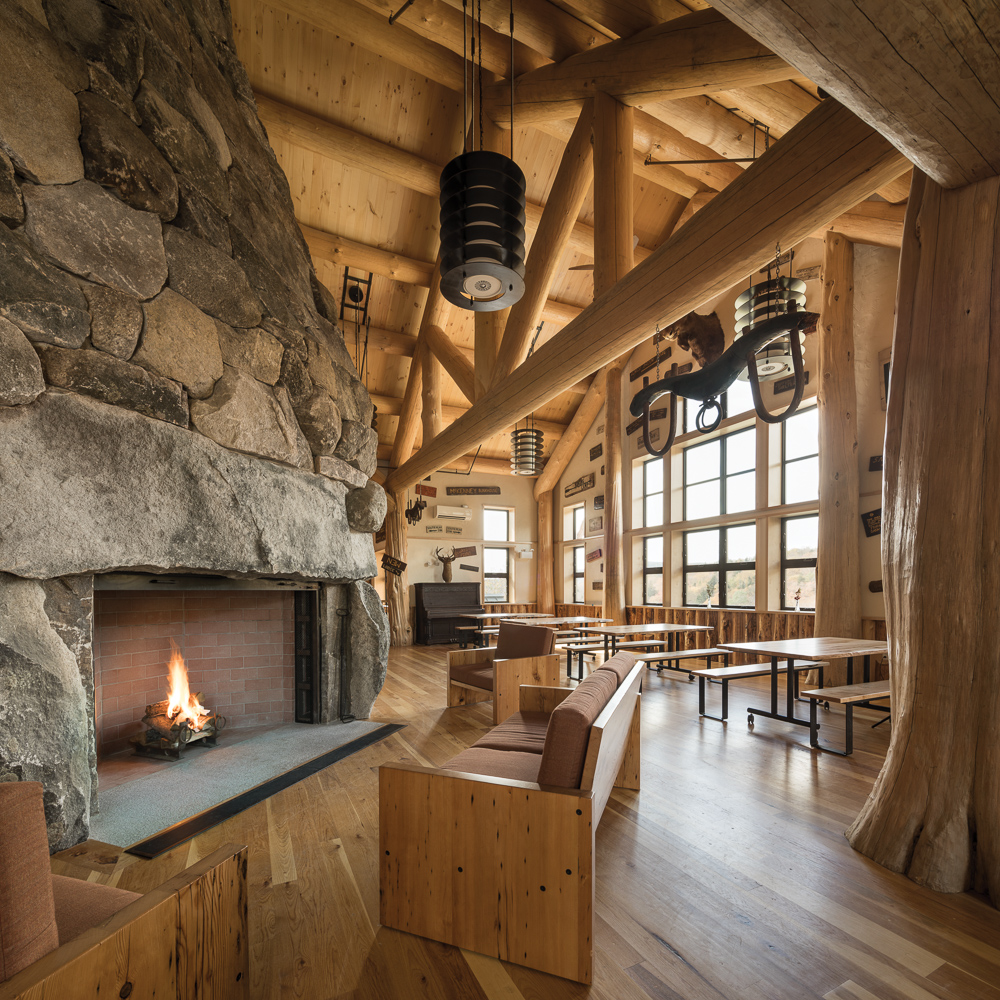
World War II came, and all that momentum stalled. Use of the Ravine Camp (as it was called until 1949) dwindled. The camp struggled financially after the war as New England’s emerging chairlift-driven ski industry enticed skiers to more accessible areas. The College folded its winter operations on Moosilauke in 1953. A decade later it offered to lease the Ravine Lodge to the Appalachian Mountain Club for a dollar a year. Through the 1960s, the lodge sat derelict and mostly abandoned—except for freshman trips in the fall and for the occasional hippies and summer campers who moved in and used the building as if it belonged to them.
It was only in the 1970s, after Dartmouth adopted its year-round calendar, and with interest in the outdoors spiking, that the Ravine Lodge came into its second life as the spiritual center of Dartmouth’s outdoor culture. Freshman trips, which had begun in 1935 with optional participation, became institutionalized. Suddenly, 70 percent of the incoming classes took part in the fall ritual (the percentage would eventually rise into the mid-90s), getting their introduction to Dartmouth and each other, not on a manicured campus but through songs and stories and shared meals in a log lodge 2,500 feet up the eastern flank of Mount Moosilauke.
Use of the Ravine Lodge expanded dramatically beyond the fall. From May through October students in the DOC managed the lodge and offered rustic accommodations and hearty family-style meals for the Dartmouth community and the general public. The burgeoning use required extensive repairs and a dramatic upgrade in water and septic systems. The College invested in a maintenance schedule. A Moosilauke advisory committee was formed, made up of students, faculty, alumni and administrators. For the first time Dartmouth began regularly monitoring the condition and safety of the building.
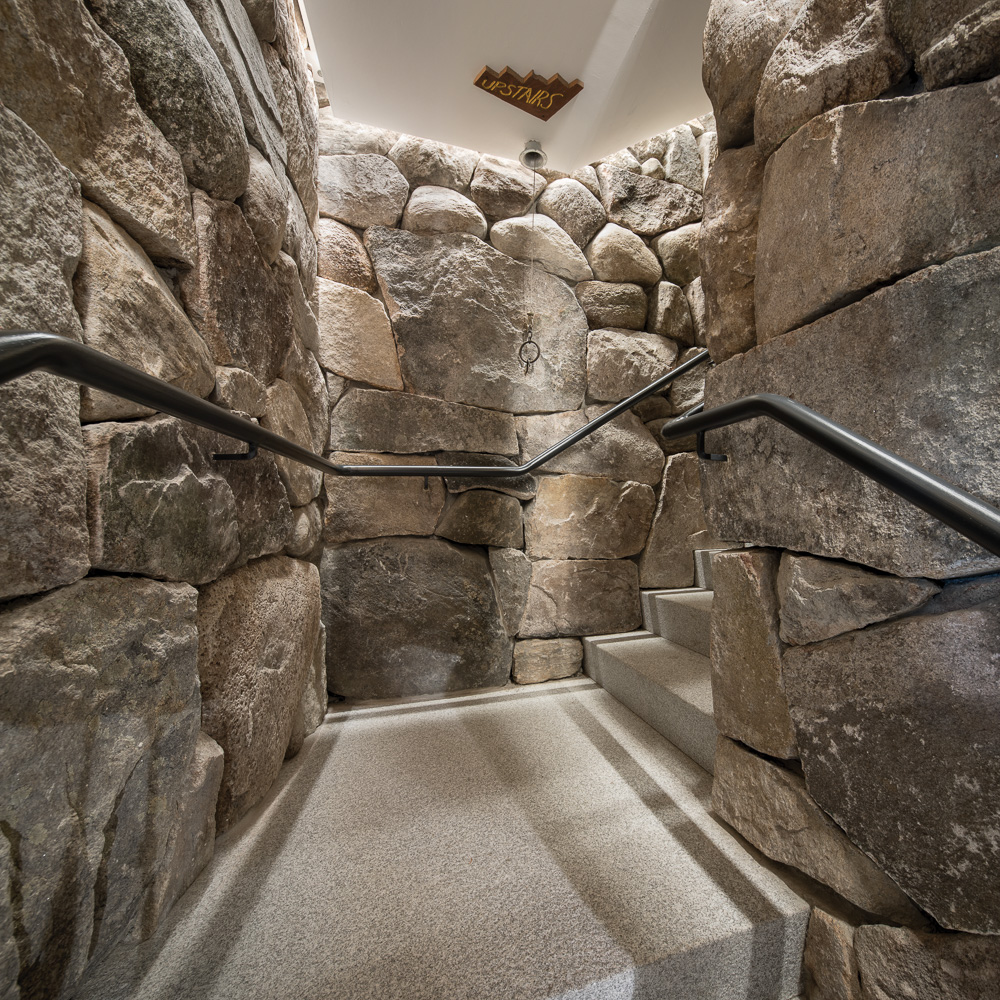

No one had ever pinned an official number on the Ravine Lodge’s life expectancy, but McKenney, and later, ski coach Al Merrill and DOC director Earl Jette, the two people at Dartmouth who pushed hardest to resurrect the old place, figured that 50 years of hard use in that unforgiving setting was the upper end of what anyone could reasonably hope for.
The crudely built lodge passed that mark in 1988.
By the time the College commissioned a comprehensive engineering study in 2014, the rot and longitudinal cracking in the spruce logs had been progressing for decades. The lodge’s corner posts had become so weakened that they were in danger of no longer supporting the loading of the roof. The accumulating freeze-thaw damage to the foundation had reached a tipping point. The constant need for repair had been growing costlier by the year. Lodge crews were losing ground to antiquated electrical and water systems. There were accessibility issues, building code issues, capacity issues. And yet the number of people who wanted to eat and sleep in the shadow of Moosilauke kept growing.
Renovating the lodge wasn’t out of the question. Indeed, strong voices inside and outside the campus community argued for just that. Former lodge crew member Craig Sakowitz ’93 spearheaded a 2015 #SaveMoosilauke campaign and launched a petition to preserve the old structure, as the Dartmouth Outing Club of Northern California had recently done with its 70-year-old cabin in Donner Pass. Alumni wrote impassioned letters to the trustees.
But the options for renovation explored by Maclay Architects of Waitsfield, Vermont, turned out to be unworkable and exorbitantly expensive. In any case, bringing the existing lodge up to code would fundamentally change much of what people loved about the old building in the first place. David Hooke ’84, a professional timber framer and member of the Moosilauke advisory committee, says it took him a long time to accept that the Ravine Lodge had to be torn down. The engineering study was unequivocal. The advisory committee ultimately endorsed the firm’s recommendation to rebuild rather than renovate.
The discussion shifted to how any new building could possibly replicate the warmth and quirkiness and rustic charm that had become an integral part of the lodge’s character. Putnam “Put” Blodgett ’53, chair of the advisory committee, made a plea for building a grand, traditional, full-log cabin. On the outing club’s email listserv, he lobbied for Dartmouth students to have the once-in-a-lifetime opportunity to help create the largest log structure in New Hampshire. It would be, he wrote, a monument to the College’s spirit and its North Country heritage. The listserv lit up with support, including a positive and detailed feasibility analysis from engineer Chris Polashenski ’07, who as a student had spearheaded the impressive full-log replacement of the DOC’s Harris Cabin in Etna, New Hampshire.
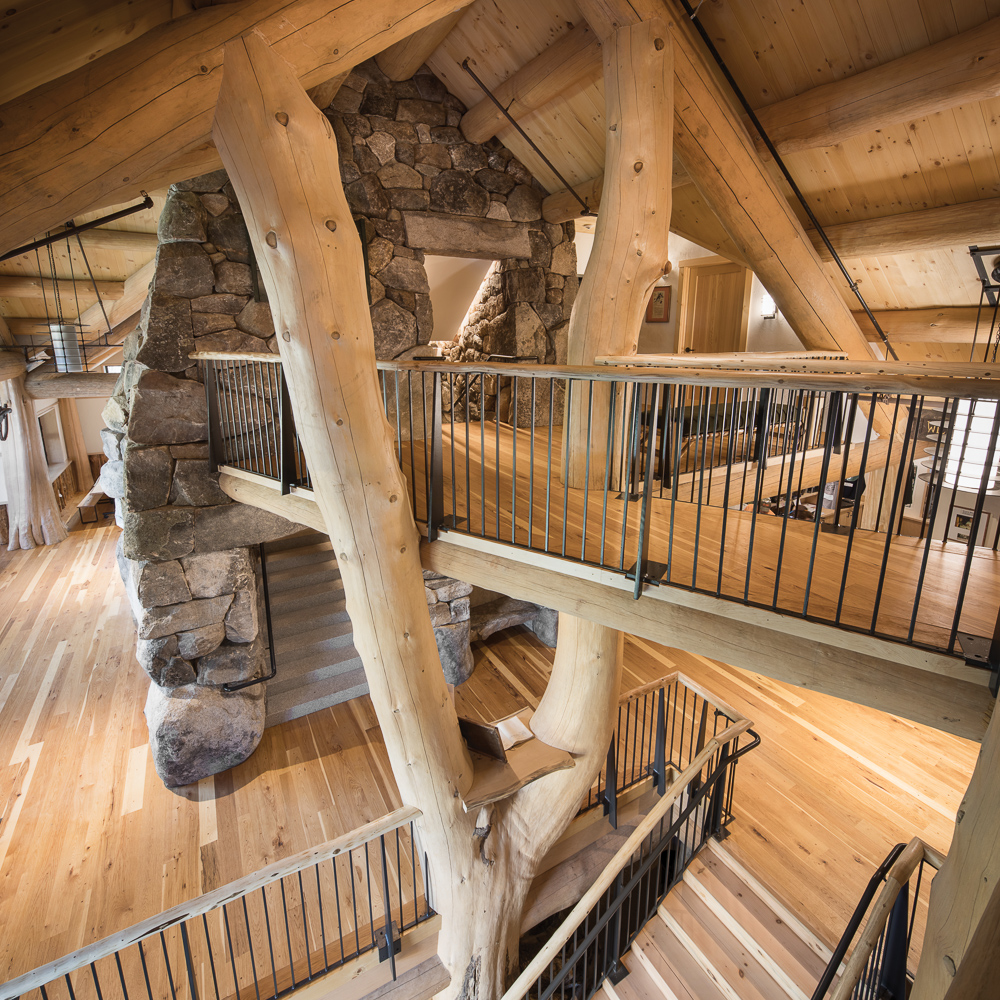
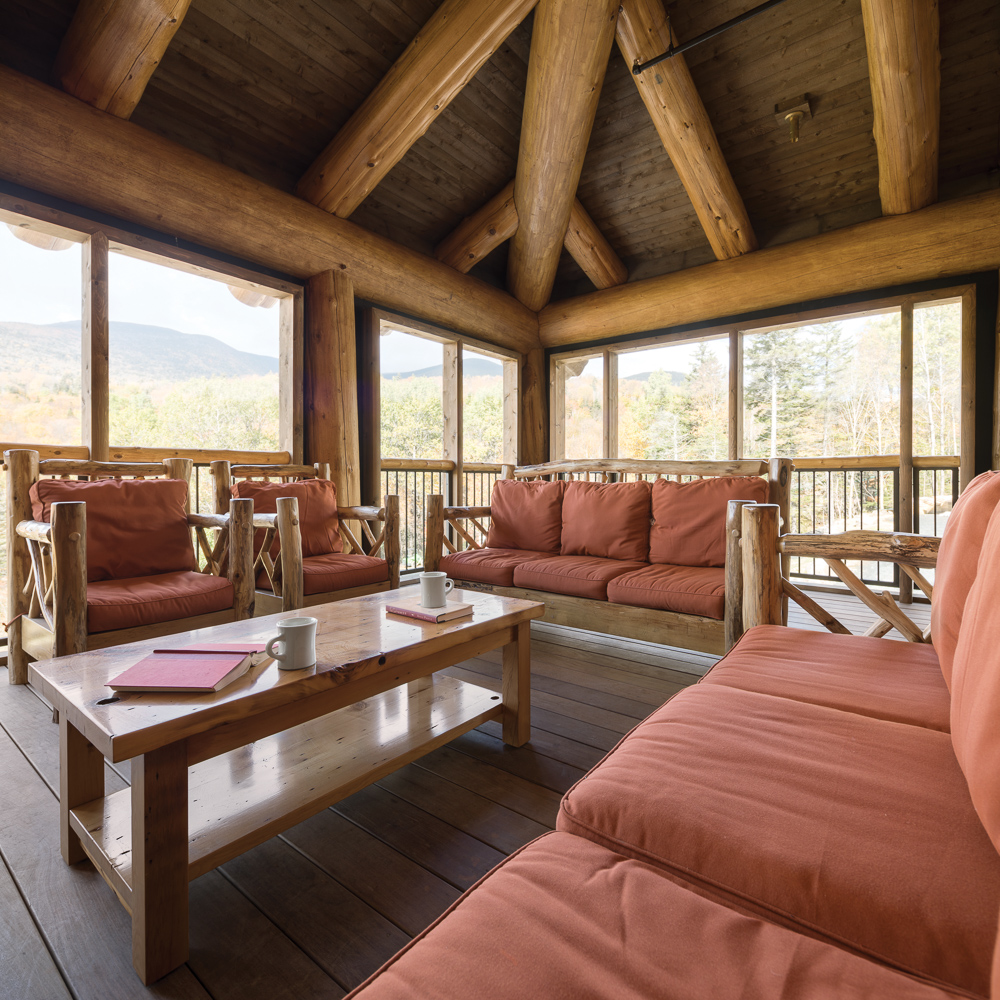
In formal and informal sessions with the community, architects Bill Maclay and Eileen Hee got an earful from all sides: not just from lovers of history and rustic
charm, but also from former lodge crew members who loved (continued on page 104) the sound of a banging screen door and the lessons they learned from fixing broken panes of glass.
They heard from former students who insisted that the central stone fireplace was the Ravine Lodge’s most important feature and from wind-and-solar environmentalists who argued that fireplaces were inefficient by nature and had no place in green design; from faculty who wanted more space for classes and from first-year trip organizers who wanted more space for feeding more people; from those who fervently believed the College—because of what it was—had an obligation to the past and from those who just as fervently believed the College—because of what it was—had an obligation to the future. Chelsea Liddell ’11 wrote in an email, “I fear that the planners will make it a comfortable place, with no shivering in the morning hours, no carrying firewood to keep it going. I fear that when I walk to the lodge, I will not walk through the woods, which, a College administrator told me, ‘is pretty intimidating,’ but that I will pull up to fancy doors and never have to know that I am part of nature.”
They heard from timber-frame proponents who talked in terms of design flexibility and insulation R-values (a measure of thermal resistance). They heard from timber-frame critics who argued that drywall and plaster were antithetical in a mountain lodge and that sawn posts and beams, even with expert joinery, even on a large scale such as the Dartmouth Skiway’s McLane Family Lodge—seemed sterile and lifeless compared to the living, breathing log cathedral McKenney had built.
College administrators ultimately drew a bright line. The new lodge would meet Dartmouth’s strict standards for low maintenance, low energy use and high efficiency. It would be a commercial building of large capacity, open to the public. As such, it would necessarily follow the American Disabilities Act requirements for accessibility and would adhere to New Hampshire’s commercial building code. “We were sensitive about what we were replacing,” says eventual project manager James Pike. “And we were aware it’s in a rugged, remote location. But in the end, we’re still Dartmouth College and this is a commercial property. It isn’t 1938. Code doesn’t allow us to build a cabin.”

Whatever its construction and features, the new Moosilauke Ravine Lodge would have an elevator, a wet sprinkler system, handrails, wi-fi and a fresh-air-exchange ventilation system. To many of those who loved the old lodge, the question was: Would it have a soul?
For the architects contemplating how to satisfy so many technical requirements and so many stakeholders with heartfelt stakes in the new building, that bright starting line might as well have been the edge of a razor.
The production schedule would be aggressive, some said crazy: teardown in early September 2016, with a new lodge completed in time for first-year trips by the end of the following summer.
At least Maclay wasn’t starting from scratch on Moosilauke. Several years earlier the class of 1984 had donated its 25th reunion gift for the construction of new lodge crew quarters, a remarkable heavy-timbered structure that showcased the class’ architects and was built, in large part, by timber-frame workshops and volunteer work parties led by the class’ own David Hooke. Its presence made a statement and instantly upped the standards of the outbuildings surrounding the lodge. Jim “Pork Roll” Taylor ’74 rallied his 40-year-reuning classmates to fund a replacement timber-framed bunkhouse to complement the new crew quarters. Maclay was invited to design the building. Other classes stepped forward with interest in upgrading the other deteriorating bunkhouses. Maclay and the College realized the site needed a fully conceived master plan to fit together all the existing, renovated and planned pieces. As outdoor programs director Dan Nelson ’75 puts it, “Maclay was already plugged into the mountain.”
Maclay had carved out a reputation for designing super-efficient buildings. The firm turned to John Nininger of the Wooden House Co. of Wells River, Vermont, for ideas. Nininger was unusual in the trade, even among master craftsmen. A member of both the timber-framers and log-builders guilds, Nininger cared deeply about tradition and energy efficiency. In addition to the traditional skills of square-rule, mortise-and-tenon joinery, dovetailed corners and hand-hewn timbers, Nininger had refined a suite of creative talents that incorporated full-scribe joinery, log gables, sanded log ends, hidden screw jacks, log archways, naturally curved timbers and a unique method of round notching for full-log construction. His log buildings were extraordinarily tight.
Nininger pulled together test results for energy efficiency from a few of his full-log buildings and showed them to Eileen Hee. “She was totally impressed,” Nininger says later. “She couldn’t believe log buildings could hit those numbers. But they didn’t meet Maclay’s super-stringent requirements.”
Nininger came up with an ambitious compromise that promised to capture the rustic warmth of logs and the literal warmth of a super-efficient envelope: a heavily insulated, mortise-and-tenon timber frame, but one joining together huge full-round logs with tons of exposed wood surfaces inside. As much as possible, he’d use the natural contours and variations in the posts and beams to create the rustic character of a true log building. In concept, it sounded stunning. Maclay and Dartmouth went for the plan.
The white pine for Nininger’s frame came from Dartmouth’s Trescott property in Etna and from Blodgett’s 709-acre woodlot in Bradford, Vermont. The logs from Blodgett’s land, especially, were striking: gorgeous mast logs—massive, long, smooth and straight as the barrel of a rifle. Blodgett was proud they’d end up on Moosilauke. He’d first climbed the mountain in 1945 and had since spent more than 130 days (he’d stopped counting) volunteering on its hiking trails. He had recently climbed to the 4,802-foot summit to celebrate his 86th birthday. He had spent most of his life on his family’s Bradford land, farming, logging and running a boys camp in summer. He remembers looking up from haying or planting and seeing the broad hulking mountain 25 miles away. “Moosilauke,” he says, “is my eastern horizon.”
During the fall of 2015 and into the winter, Blodgett, Nininger and Hee searched the woodlot for appropriate timber. “I’m not wealthy,” Blodgett says, “but I could give Dartmouth trees. I gave them my best.”
The following June, as Blodgett was waiting for a trailer load of his pine to be emptied at Nininger’s field, he wandered to the back of the truck and counted the tree rings in the log butts. They averaged 101 years old. Some of the logs, 60 feet long, would have to be cut because they were longer than any of the logs specified in the plan. “It broke my heart,” Blodgett says.
Nininger had also located a rare stand of eastern white cedar just north of Wells River. Those cedars—extraordinarily large, with impressive root flares—tapered too fast to be used as long carrying members, but were exquisitely suited for the vertical posts in Nininger’s plan. During the end of a warm February in 2016, when the ground was frozen, Nininger’s crew pulled a hundred of them out of the wetland.
As the log stockpile grew in Wells River, interestingly shaped and curving logs were set aside and imagined into the frame. The crew lived with the wood, studied it, spent, on occasion, more than a day positioning and subtly turning and measuring and repositioning and remeasuring a single branching or complex log, running lasers to get a true center line and ensure the cuts would deliver the engineering. The massive Y-shaped pine designated “F-9” on the framing grid was affectionately referred to as “Slingshot.” “Three-Tooth” was the name they gave the log that branched out with upright arms, like a saguaro cactus. It would make a perfect, if technically difficult, corner post. A smaller log with an inosculation—where a branch had bent back and re-embedded itself—was first dubbed “Cyclops” for its resemblance to a giant single eye, and then “Odysseus,” for the way that sounded. It would be integrated into the pediment on the lodge’s southwest, mountain-facing entrance.
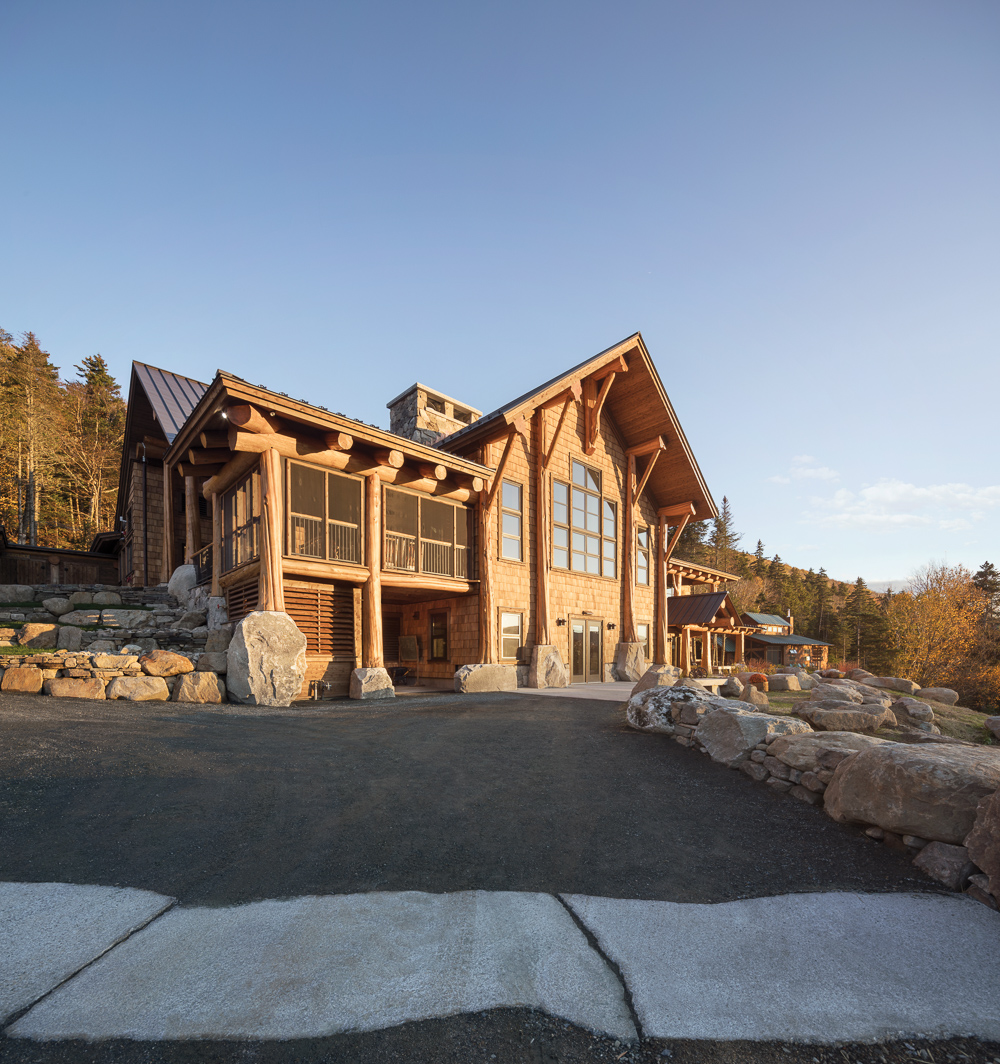
The workers used $400 log scribes with custom levels made in Vershire, Vermont, to mark the tight-fitting cuts that traced 20 inches and more around the surfaces of the round logs. Some of the joinery was inspired by Nininger’s knowledge of thousand-year-old buildings in Europe. Some of the joinery the workers invented themselves, specific to the logs they would attach: complex angles, tapers in different dimensions, rafter-to-post connections with lateral stability in two directions, a tricky interlock that Nininger came up with to eliminate the need for external steel plates in the asymmetrical truss just north of the planned stone fireplace. Each joint needed to be evaluated and approved by the project engineer. “Once he saw what we were doing,” says Nininger, “he pretty much trusted us.”
Nininger’s crew—and Hooke’s crew, for parts of the job—put in 60-hour weeks during eight months preparing and building the frame—some 20,000 hours in all. They marked, cut and assembled the entire frame upside-down, before disassembling it and trucking the finished logs to Moosilauke as winter closed in on the mountain. Some of the assemblies in the roof structure alone weighed five tons.
All winter and through a protracted mud season, while extreme weather dumped more rain and snow on the mountain than any year in recent memory, the ravine filled with the sound of wind, diesel engines, pneumatic drills, back-up beepers. Simply keeping the access road open for the construction vehicles was a challenge. Workers—some commuting more than two hours each way—arrived in the dark and left in the dark. They poured the new foundation under the same difficult conditions McKenney had faced. They erected an interior steel skeleton and raised and sheathed Nininger’s wild and natural frame.
Surprisingly, the rocky slopes of the ravine—even disturbed by excavation—didn’t reveal enough massive, high-quality stone for the central fireplace envisioned by mason Joe Rolfe of Belmont, New Hampshire. Rolfe was, according to project manager James Pike, one of the best in the business. “What he does,” says Pike, “is not ‘normal’ masonry.” Rolfe identified several huge boulders on the site—one of them weighing 22 tons—that he could cut flat on a side and drill through and use as organic foundation stones for the cedar posts. But the motherlode came from Roger Belisle’s granite quarry in Hooksett, New Hampshire. Rolfe spent three days walking around the quarry, hand-picking the stones that would give him the 30 inches of depth he needed for the chimney’s bottom course, the thick 11-footer that would beautifully serve as the lintel above the fireplace, the 250 tons that would create the intricate and challenging 20-by-20-foot masonry column that would encase the fireplace as well as a grotto and a hidden interior staircase. “To do justice to that lodge,” says Rolfe, “I felt compelled to use some really large stones. The scale of the building, the scale of the logs and the scale of the fireplace all had to be in line.”
Last May Rolfe’s crew of masons was in the midst of its 80-day push. Rolfe, occasionally, allowed himself to think of the future. “I work primarily for affluent customers who spend millions on their homes,” he says. “And the last thing we do is the gated entrance. Very few people get to see our work. I’m 54 years old now and I have a grandson. I love that he’ll have the chance to someday see what we’ve done here and say, ‘My grandfather built that.’ And a lot of my guys feel that same way.”
The building was weathertight, eastern white cedar shingles were going up on the exterior walls, and sub-contractors were jockeying for space around mechanical, electrical, plumbing and fire-protection systems. But the schedule, in large part because of tough weather, had slipped more than a month. The College announced that the new building wouldn’t be ready for the first-year trips after all. The trips, this year, would converge at the Skiway’s McLane Family Lodge.
In the summer the job turned to finish work. The best of the logs from the old lodge had been set aside and trucked to a portable sawmill, where they were sawn into half-rounds and one-and-a-quarter-inch slabs with live edges that now colored interior walls and wainscoting. Other logs had been sliced into sections, the disks turned into thank-you mementos for contributors to the project. Two original transom lights found new use as interior windows. One of the wagon-wheel light fixtures went back up on the ceiling. A craftsman in Springfield, Vermont, was building the lodge’s new furniture from sustainably harvested wood from the College Grant and salvaged material from old New England plank houses. The old wooden screen door, obsolete in the new, energy-efficient airlock entrance, was fitted for banging on a side porch. The old trail signs and wooden skis and campy memorabilia sat in storage in Taylor’s Class of ’74 Bunkhouse. The new lodge crews would add them back in their own fashion starting in the fall.
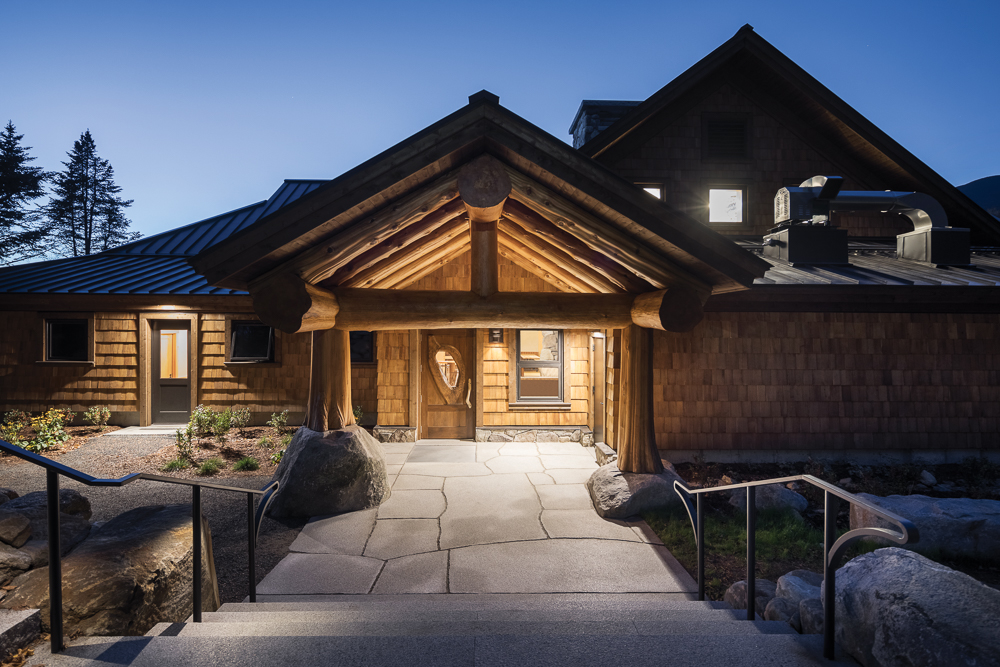
To anyone who had hiked into the construction site or knew about the details of the construction, there was no question about the College’s commitment. Where a property had once been all but abandoned and nearly given away, Dartmouth started to raise $11 million for the construction of a magnificent new lodge and an additional $5 million to endow its ongoing maintenance for generations of students to come. (The College still needs to raise $5 million of the $16 million total.) The commitment went beyond replacement. It added 5,000 square feet of space, including a larger kitchen, additional bathrooms, new meeting and multi-purpose rooms, and an expanded main hall that could seat 120 people for dining, nearly double the capacity of the old lodge. “The new lodge will serve more people per day for more days throughout the year,” noted George “Skip” Battle ’66, who was the lead financial contributor to the project and who hosted a party for the workers on the mountain, complete with Dartmouth’s own house bluegrass band. “It will be,” he says, “dramatically more available.”
The planners had thoughtfully preserved the original lodge’s crossing-gable, T-shaped plan, the side porches, the familiar layout of kitchen on the north side, bedrooms on the south, lounge and library downstairs. They’d added limited wi-fi capability for academic use in specific rooms, but kept the wireless-free, device-free environment for guests. (For reliable cell coverage, students will still have to run down to Warren and stand outside the library or find the sweet spot higher up Route 118.) Importantly, the planners had also preserved Butterfield’s bold perch, the lodge facing straight up at the mountain. The relationships would be the same. “Some things about this place are very concretely physical,” says Dan Nelson. “Some are metaphysical.”
Pike struggles to compare the cost to conventional projects, because, as he points out, there was nothing conventional about this facility. In the terms of the trade and across higher education, there were simply no comparables. The cost reflected a commitment to local materials and craftsmen and to energy efficiency. It reflected a commitment to a 100-year timeline, including a 12,000-head sprinkler system, three new sewer tanks and a 3,000-gallon domestic water tank with a new water line to the upper road. It reflected a commitment to a sacred but challenging site, which required extended siting and infrastructure costs that involved moving one building and constructing a separate smaller one, boulder retaining walls, and hardscaping and landscaping that would somehow soften all of the scarring and make the new lodge feel like an organic part of the ravine. It reflected a commitment—through its accelerated schedule—to minimizing the disruption of the student experience on Moosilauke.
The question of a building’s soul was still outstanding.
What did a building’s soul have to do with the people who gathered there? How much of it was formed by building materials and layout, and how much by rituals and collective memory? By shared love? By Dickey’s sense of place loyalty?
The McLane Family Lodge at the Skiway doesn’t feel homey, an alum pointed out, because there aren’t students working and living there, making it their home.
Another alum had hiked in to the construction site as the workers were putting on the finishing touches and had seen the fresh-cut granite steps leading down from the access road to the new lodge. “They feel like steps to a city library,” he said to his buddy, a Middlebury grad. “At least they had the sense to scrap the plan to have a ‘luggage slide’ along the stairs. Can you imagine that, on Moosilauke?”
“Are you kidding me?” his buddy answered. “Can you imagine what Dartmouth students would have done with a luggage slide?”
In her class’ 25th reunion book, former DOC president Viva Hardigg ’84 wrote: If the lodge must be rebuilt, I feel wholeheartedly that the spirit of the place is much grander than the fine old building itself. While honoring spruce logs and hand-carved joinery, our deepest commitment is to one another and the sacred strength of a common hearth, far from commerce and close to wilderness. We return to the sanctuary of the ravine because of the glory of the mountain and the distinct New England alchemy of wood smoke, oral storytelling, fiddle music, pots of tea, wool sweaters and other idiosyncratic ingredients of rustic mountain hospitality. The rituals of the culture will continue as one generation teaches the next.
It will take time for the new Moosilauke Ravine Lodge to soften under the touch of hands, the feeling of feet having walked for years over the same boards. It will take time for the students to make the new building their own, to discover its quirks and charms, to create new rituals and pass them down. The mountain will anchor them.
Jim Collins is working on a book that will celebrate the College’s forthcoming 250th anniversary.
